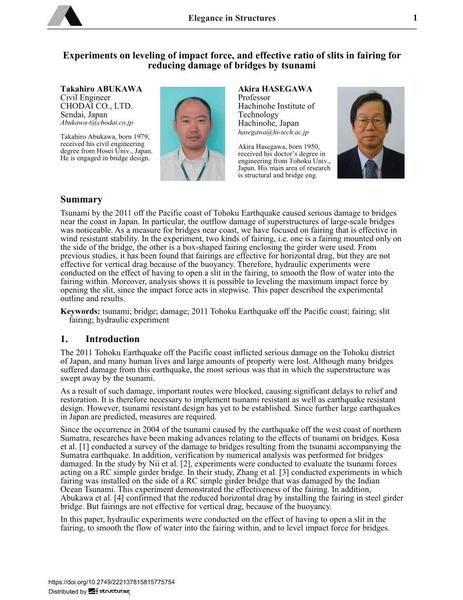Experiments on leveling of impact force, and effective ratio of slits in fairing for reducing damage of bridges by tsunami

|
|
|||||||||||
Bibliographic Details
| Author(s): |
Takahiro Abukawa
Akira Hasegawa |
||||
|---|---|---|---|---|---|
| Medium: | conference paper | ||||
| Language(s): | English | ||||
| Conference: | IABSE Conference: Elegance in structures, Nara, Japan, 13-15 May 2015 | ||||
| Published in: | IABSE Conference Nara 2015 | ||||
|
|||||
| Page(s): | 444-445 | ||||
| Total no. of pages: | 8 | ||||
| Year: | 2015 | ||||
| DOI: | 10.2749/222137815815775754 | ||||
| Abstract: |
Tsunami by the 2011 off the Pacific coast of Tohoku Earthquake caused serious damage to bridges near the coast in Japan. In particular, the outflow damage of superstructures of large-scale bridges was noticeable. As a measure for bridges near coast, we have focused on fairing that is effective in wind resistant stability. In the experiment, two kinds of fairing, i.e. one is a fairing mounted only on the side of the bridge, the other is a box-shaped fairing enclosing the girder were used. From previous studies, it has been found that fairings are effective for horizontal drag, but they are not effective for vertical drag because of the buoyancy. Therefore, hydraulic experiments were conducted on the effect of having to open a slit in the fairing, to smooth the flow of water into the fairing within. Moreover, analysis shows it is possible to leveling the maximum impact force by opening the slit, since the impact force acts in stepwise. This paper described the experimental outline and results. |
||||
| Keywords: |
bridge damage tsunami fairing 2011 Tohoku Earthquake off the Pacific coast hydraulic experiment slit fairing
|
||||
